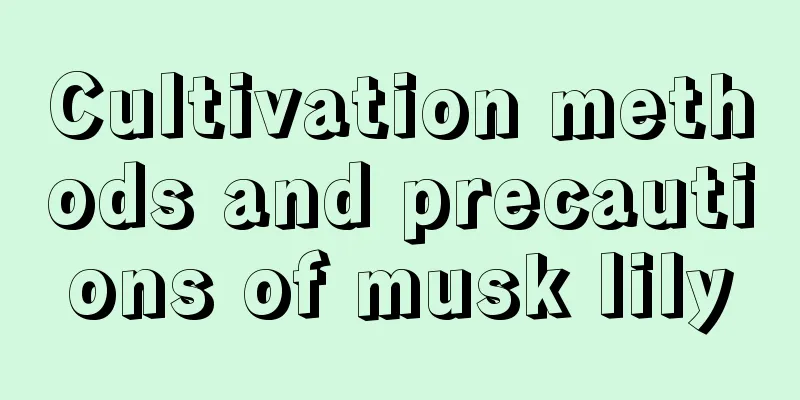Cultivation methods and precautions of musk lily

How to grow musk lilyPot soilChoose a flower pot with good air permeability and put a substrate in it. It should be rich in humus and have good drainage. You can mix leaf mold, garden soil and fine sand. The soil should be slightly acidic. As the musk lily grows, it is best to change the potting soil every year. Light and temperatureMusk lily is a long-day plant, and the length of daylight hours has an important influence on the growth and flowering of musk lily. Musk lily requires sufficient light, preferably diffuse light, to avoid direct sunlight. In summer, the sunlight is strong and needs to be shaded. In winter, the daylight hours are short and lights can be used to supplement the light. Musk lily likes warmth and can grow normally at temperatures between 10℃ and 25℃, but temperatures below 5℃ or above 25℃ will affect the growth and flowering of the plant. It is necessary to do a good job of temperature control to maintain the appropriate temperature for flowering. Water and fertilizer managementGood water and fertilizer management is also the key to the good growth of musk lily. Watering should be appropriate, and it is best to keep the soil in the pot slightly moist. The air humidity should be maintained at a high level at ordinary times. You can spray water on the plant frequently, but do not allow water to accumulate in the pot. Fertilization work must also be done properly. Before flowering, in order to ensure sufficient nutrients, you can apply thin liquid fertilizer once every half a month, and some phosphorus fertilizer and potassium fertilizer can be applied during flowering. Precautions for the cultivation of musk lilyFlowering precautionsMusk lilies are mainly grown for viewing their flowers, and flowering is very important. During its growing season, the flowerpot should be turned frequently to avoid plant deformity; provide sufficient light, as too much shade will reduce flowering; maintain adequate water; remove the remaining flowers of the musk lily in time after flowering; and pay attention to the prevention and control of diseases and pests. Pests and diseasesDuring the growth period, musk lilies may suffer from blind flower or flower cracking diseases, and may also be attacked by soft rot and leaf spot diseases. In addition, musk lilies are attacked by pests such as spiny-footed root mites and white grubs. Reproduction methodMusk lily is a bulbous flower, and bulb division is its main way of propagation. In addition, musk lily can also be propagated by scale cuttings or sowing.
|
<<: Cultivation methods and precautions of Linaloa
>>: Songmei cultivation methods and precautions
Recommend
How to grow a potted golden jujube tree? How to grow a golden jujube bonsai
Potted cultivation method of golden jujube tree 1...
The difference between snow peas and peas
1. Differences in varieties Peas are actually a r...
How to grow white palm in a pot? How to grow white palm in a pot?
How to grow white palm in a pot Anthurium prefers...
Butterfly flower disease and insect pest control methods
Common diseases Bacterial soft rot symptom It is ...
Is it difficult for a novice to choose flowers? These “3 types” are good. Just water them and the pot will be full in 30 days!
In fact, if you are afraid that you will not be a...
When is the best month to prune the fortune tree? It needs pruning every year (pruning in April and May)
Pruning time of fortune tree The money tree is us...
How often should I water Photinia
How often should I water Photinia Don't water...
Can Jade Dew be exposed to the sun? Is it okay without sunlight?
Can Jade Dew be exposed to the sun? Jade plant ca...
What should I do if Euphorbia milii loses its leaves?
Overwatering The first reason may be that too muc...
The difference between syrup and wax apple
1. Differences between tree trunks The sycamore c...
Cultivation methods and precautions of Rieger Begonia
1. Soil The specific requirements for it are loos...
Don't just grow green radish and spider plants, these flowers are so beautiful, why don't you try them
Freesia (Author: Buy pictures online Source: Nitu...
Why can't you grow flowers in a greenhouse?
1. Can it be raised? Flowers can be grown in a gr...
Are lilies poisonous when placed indoors?
1. Is it toxic? Lily is a non-toxic flower and it...
How to remedy the yellowing of lychee leaves
1. Fertilization If the leaves of litchi trees tu...









